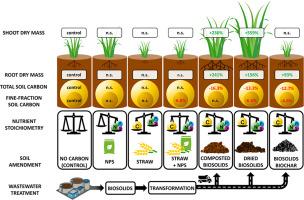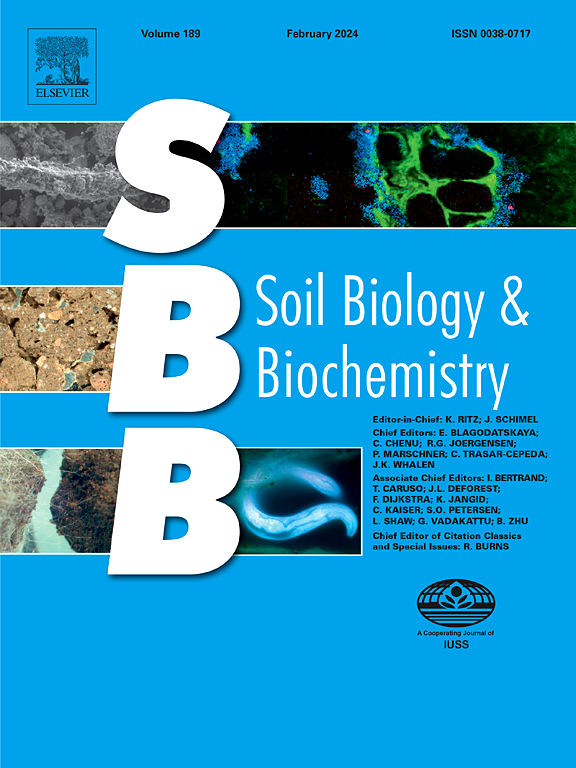Transformed biosolids promote ryegrass growth and microbial carbon cycling at the ‘cost’ of soil carbon
IF 9.8
1区 农林科学
Q1 SOIL SCIENCE
引用次数: 0
Abstract
Soil carbon supports desirable ecosystem functions for global agricultural productivity and climate resilience objectives. Wastewater biosolids can be transformed into soil amendments that return carbon and nutrients to agricultural systems in stoichiometric ratios that support carbon stabilisation. However, practicable delivery that enhances stable soil carbon and plant yield remains challenging. Soil carbon stability and nutrient availability are mediated partly by microbial community composition and function, which are poorly understood in soils amended with transformed biosolids. We conducted a 56-day study in a temperature-controlled glasshouse, growing perennial ryegrass (Lolium perenne) in pasture soil amended with straw, straw supplemented with nutrients, or transformed biosolids (composted biosolids, dried biosolids or biosolids biochar), all with equal added carbon (3500 kg ha−1). Control soils, with and without supplementary nutrients, were also included. Plant dry mass, soil chemical characteristics, and soil carbon fractions were measured at harvest. 16S rRNA sequencing was used to infer the composition and putative function of rhizosphere bacterial communities. Shoot dry mass increased for composted biosolids (236%) and dried biosolids (559%), but total carbon in rhizosphere soil decreased for composted biosolids (16.3%), dried biosolids (13.3%) and biosolids biochar (12.7%) when compared to unamended soils. Fine-fraction carbon in rhizosphere soil decreased for straw with supplementary nutrients (6.8%), dried biosolids (6.3%) and biosolids biochar (4.6%). Rhizosphere bacterial communities clustered by treatment, with populations correlated with fine-fraction carbon distinct from those populations correlated with shoot and root dry mass. Path analysis linked fine-fraction carbon loss with increased putative carbon cycling genes, driven by available nutrients and plant growth. Transformed biosolids can trigger a microbial response that reallocates nutrients from organic matter to plants, disrupting soil carbon-nutrient stoichiometry and facilitating carbon loss. Understanding the carbon cost of this ecosystem service is fundamental when translating benefits of transformed biosolids to end users.

转化生物固体以土壤碳的 "代价 "促进黑麦草生长和微生物碳循环
土壤碳支持理想的生态系统功能,以实现全球农业生产力和气候适应性目标。废水生物固体可转化为土壤改良剂,以支持碳稳定的化学比率将碳和养分返还给农业系统。然而,提高土壤碳稳定性和植物产量的实际交付仍具有挑战性。土壤碳稳定性和养分可用性部分受微生物群落组成和功能的影响,而人们对用转化生物固体改良土壤的微生物群落组成和功能知之甚少。我们在温控玻璃温室中进行了一项为期 56 天的研究,在添加了秸秆、秸秆养分或转化生物固体(堆肥生物固体、干生物固体或生物固体生物炭)的牧场土壤中种植多年生黑麦草(Lolium perenne),所有添加的碳量相同(3500 千克/公顷)。此外,还包括添加和不添加养分的对照土壤。收获时测量植物干重、土壤化学特征和土壤碳组分。16S rRNA 测序用于推断根圈细菌群落的组成和功能。与未经改良的土壤相比,堆肥生物固体(236%)和干燥生物固体(559%)的嫩枝干重增加了,但堆肥生物固体(16.3%)、干燥生物固体(13.3%)和生物固体生物炭(12.7%)的根瘤土壤总碳量减少了。添加了补充养分的秸秆(6.8%)、干生物固体(6.3%)和生物固体生物炭(4.6%)根瘤土壤中的细粒碳减少。根圈细菌群落按处理分组,与细馏分碳相关的种群不同于与芽和根干质量相关的种群。路径分析显示,在可用养分和植物生长的驱动下,细馏分碳损失与推定碳循环基因的增加有关。转化后的生物固体可引发微生物反应,将养分从有机物重新分配给植物,从而破坏土壤碳-养分平衡,促进碳流失。在将转化生物固体的益处转化为最终用户时,了解这种生态系统服务的碳成本至关重要。
本文章由计算机程序翻译,如有差异,请以英文原文为准。
求助全文
约1分钟内获得全文
求助全文
来源期刊

Soil Biology & Biochemistry
农林科学-土壤科学
CiteScore
16.90
自引率
9.30%
发文量
312
审稿时长
49 days
期刊介绍:
Soil Biology & Biochemistry publishes original research articles of international significance focusing on biological processes in soil and their applications to soil and environmental quality. Major topics include the ecology and biochemical processes of soil organisms, their effects on the environment, and interactions with plants. The journal also welcomes state-of-the-art reviews and discussions on contemporary research in soil biology and biochemistry.
 求助内容:
求助内容: 应助结果提醒方式:
应助结果提醒方式:


